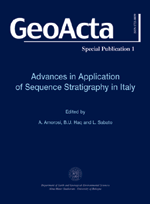GeoActa Special Publication 1
2008


Acquisto online |
GeoActa
an international Journal of Earth Sciences
|
|
Alessandro Amorosi1, Alessandro Fontana2, Fabrizio Antonioli3, Sandra Primon2 and Aldino Bondesan2
1Dipartimento di Scienze della Terra e Geologico-Ambientali, University of Bologna, Via Zamboni 67, 40127 Bologna, Italy. E-mail: alessandro.amorosi@unibo.it
2Dipartimento di Geografia, University of Padua, Via Del Santo 26, 35123 Padova, Italy. E-mail: alessandro.fontana@unipd.it, sandra.primon@unipd.it, aldino.bondesan@unipd.it
3ENEA ACS, Casaccia, Roma. E-mail: fabrizio.antonioli@enea.it
|
|
|
Post-LGM sedimentation and Holocene shoreline evolution in the NW Adriatic coastal area
|
|
|
|
|
|
|
|
PDF (2,9 MB)
|
Abstract
A comprehensive study of the post-Last Glacial Maximum (LGM) coastal succession of the northwestern Adriatic Sea was carried out between Ravenna and Isonzo River, based upon the critical re-examination of pre-existing literature and analysis of the large stratigraphic database made available by the recent national mapping project. With the aid of seven cross-section transversal to the present shoreline, this study revealed common stratigraphic features for the NW Adriatic coastal region across the investigated sectors, but also a peculiar sedimentary evolution for the Romagna and the Venetian-Friulian coastal plains, south and north of Chioggia, respectively.
Above the LGM alluvial deposits, the Ravenna and Comacchio coastal plains, as well as the subsurface of modern Po Delta, display a remarkably homogeneous stratigraphic framework: this includes a transgressive-regressive depositional cycle of Holocene age, approximately 30 m thick, made up of retrogradational back-barrier, transgressive shoreline and offshore-transition deposits, overlain by a shallowing-upward succession of prodelta, delta front, delta plain and alluvial plain sediments. This stratigraphic architecture reflects the landward migration of barrier-lagoon-estuary systems (transgressive systems tract), followed by extensive deltaic and coastal-plain progradation (highstand systems tract). In contrast, the post-LGM succession of the Venetian-Friulian Plain is thinner (generally less than 15 m) and consists almost entirely of lagoonal deposits, with only subordinate nearshore sands. Early transgressive (late Pleistocene) deposits are preserved as lenticular alluvial deposits, filling either large and deep incisions formed close to the turnaround from lowstand to transgressive conditions (incised-valley fills - IVF - in the Venetian-Friulian Plain) or smaller-sized topographic depressions mostly inherited from pre-existing topography (Romagna Plain).
The transgressive surface (TS), corresponding to a stratigraphic discontinuity that encompasses almost invariably the Pleistocene-Holocene boundary, is a laterally extensive surface that can be easily tracked across the study area through core correlation, for a distance of about 250 km. On the interfluves, the TS coincides with a diagnostic pedogenized and indurated horizon that records a non-depositional hiatus of 7 to 10 ka of duration. This study documents that the onset of transgressive sedimentation was progressively younger from south to north, due to the onlapping geometry of the transgressive deposits onto the east-and-south-dipping LGM unconformity. This paper also provides, for the first time, a depiction of maximum marine ingression during the Holocene over the NW Adriatic coast, through detailed mapping of i) the maximum landward migration of the shoreline, and ii) the maximum landward migration of the brackish (lagoonal and marsh) environments.
A reliable understanding of the dynamics that controlled changes in stratigraphic architecture in the study area should keep into account a number of factors, including allogenic versus autogenic processes. Specifically, this study shows that a different influence of the isostatic component of sea-level change affected the study area (Venice versus Friuli) during the Holocene. Similarly to what observed for the Last Interglacial deposits, tectonic subsidence appears to have exerted a major control on sedimentation in the Po coastal plain during the Holocene, generating additional accommodation space for coastal sedimentation. On the other hand, the peculiar stratigraphic architecture of the Venetian-Friulian Plain east of the Venice Lagoon, showing an abundance of lagoonal deposits with negligible sand accumulation, is related to the dramatic reduction in sediment supply that took place since the onset of deglaciation, in response to the shifting of the Alpine rivers from a fluvio-glacial to a fluvial regime.
Keywords: Sequence stratigraphy, Last Glacial Maximum, Holocene, Po Plain, Venetian-Friulian Plain, Adriatic coast
|
|
|


